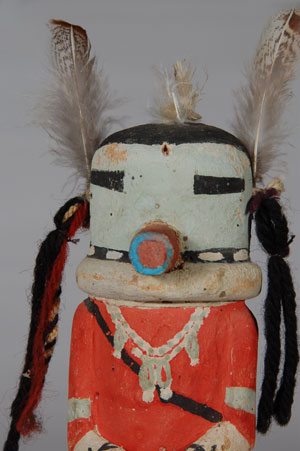Hopi Second Mesa Version of Kahaila Katsina [SOLD]
+ Add to my watchlist Forward to Friend
- Category: Traditional
- Origin: Hopi Pueblo, Hopituh Shi-nu-mu
- Medium: cottonwood, pigments, yarn, feathers
- Size: 8” tall
- Item # 25500 SOLD

This katsina, sometimes call the Mak Katsina, is considered to be an import from Laguna Pueblo to the Hopi Mesas. This version is from Second Mesa as defined by wearing a red shirt or red painted body.
This katsina was illustrated by Jesse Walter Fewkes in Plate XLVII of his publication Hopi Kachinas but Fewkes referred to him as "Kwacas Alex Taka," which translates to "eagle feathers erect man" which is based on the two erect feathers on the head.
Fred Kabotie, famous Hopi artist, illustrated a pair of this katsina in his 1938 watercolor painting "Hunting Dance from Laguna." The katsina is sometimes referred to at Hopi as a Hunter Katsina.
The katsina doll is painted with blue mineral paint on the face, armbands, skirt hem and moccasins. The white neck ruff and white skirt appear to be mineral paint as well. The red could be aniline paint. The katsina doll probably dates to no later than the 1930s.
Condition: The katsina doll is really in excellent condition for a carving of its age.
Provenance: From a private collector
References: Fred Kabotie: Hopi Indian Artist, an autobiography told with Bill Belknap, Museum of Northern Arizona. 1977.
Kachinas: A Hopi Artist's Documentary by Barton Wright, Northland Press, 1973.
- Category: Traditional
- Origin: Hopi Pueblo, Hopituh Shi-nu-mu
- Medium: cottonwood, pigments, yarn, feathers
- Size: 8” tall
- Item # 25500 SOLD



